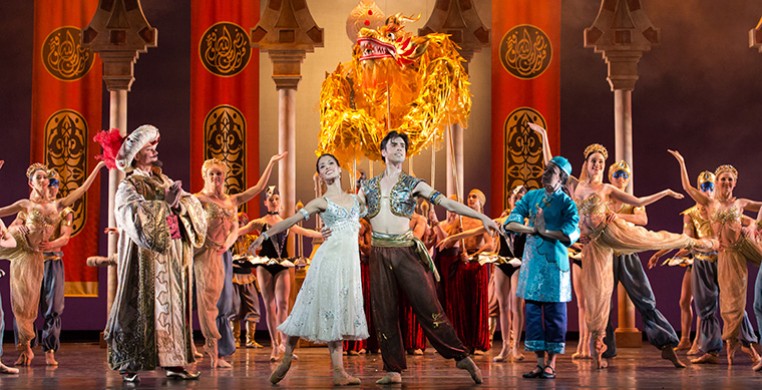Houston Ballet made its Chicago debut this weekend with two performances of the lavish full-length ballet Aladdin. Chicago is only the fourth city to view the ballet, with previous performances in Houston, London, and Tokyo. Artistic Director Stanton Welch is no stranger to Chicago, having choreographed a new version of La Bayadere performed by the Joffrey Ballet last Fall. Welch didn’t choreograph Aladdin, but the commission of David Bintley for the new story ballet is clearly in line with his aesthetic. So much effort has been paid to re-inventing ballet of late, stripping away old protocols and traditions. Aladdin combines the age-old conventions of the story ballet and classic ballet choreography, yet does not feel dated. This, perhaps, is because of newer technologies employed in the elaborate sets, such as color-changing LED stalactites and stalagmites in the Cave of the Riches, moving lights and vertigo gobos, and rigging of the Genie and a magic carpet to create the illusion of flight over the stage. On the whole, Houston Ballet pulls all of it off with seamless elegance, leading one to think that the conventional story ballet isn’t dead, and that perhaps there are stories yet to be told in this format.
Houston Ballet’s Aladdin is not all that different from Disney’s version; the beautiful world created onstage is filled with lively characters (and a huge cast), making this an ideal ballet for children and families. The reasons to love Aladdin are the same reasons American audiences love the Nutcracker, and for better or worse the two are fraught with equivalence. Particularly “Nutcracker-y” is the previously mentioned Cave of the Riches. Aladdin is enticed into the cave by a sorcerer, and then the plot disintegrates to create an excuse for a series of divertissements. Aladdin (like Clara in the Land of the Sweets) looks on as he’s entertained by various precious gems in ballerina form, including a full-on Waltz of the Diamonds with music suspiciously similar to Tchaikovsky's Waltz of the Flowers (perhaps by design, perhaps not).
In fact, Carl Davis’ musical score is a bit confused in general. At times it channels Prokofiev, as it sweeps and swells with a hint of atonal in the wedding and bath house scenes. At other moments it feels more like the score from Jurassic Park. This is sometimes disconcerting, sometimes totally endearing. Davis' music, as purplexing as it may be, supports the storyline well and creates a few delightful character moments. Though she probably doesn’t realize it, Jessica Collado practically steals the show as Aladdin’s mother, using musical highlights and massive facial expressions to full advantage.
Connor Walsh and Karina Gonzales, as Aladdin and Princess Badr al-Budur (Jasmine) respectively, are delightful to watch, as is Christopher Gray as The Genie. The standard across the board is technical panache and effortless execution, from the Princess all the way down to the corps de ballet, whose choreography is much more demanding than the "stand there and look pretty" roles in traditional full-length ballets. Not often do you see corps members running into unison shoulder sits with 50 other people onstage. Correction: the last time this reporter encountered it was in Welch’s La Bayadere last Fall. I did mention that the aesthetic was similar, right?

